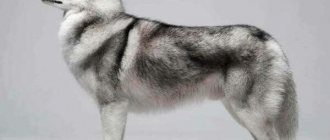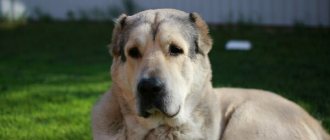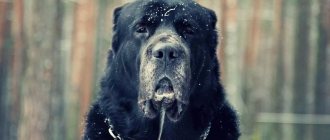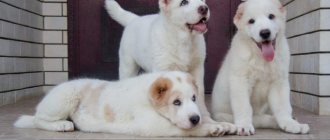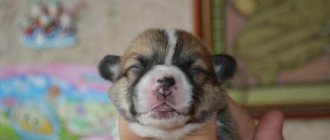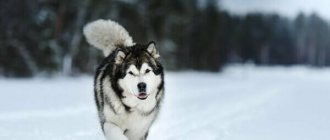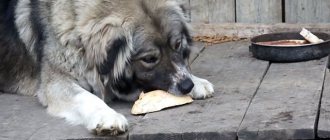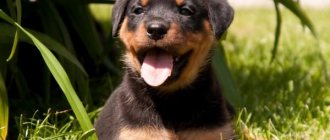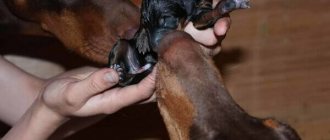Husky is an amazing dog. Many, having seen the expressive look of blue eyes in the photo and read about their good-natured character, dream of having such a pet. But representatives of this breed are not suitable for everyone. They require special conditions of detention, good upbringing and serious physical activity. After all, this is a working, sled dog, whose homeland is Siberia and the Far North. But despite this, huskies are a popular breed. People like not only her unusual appearance. Dog lovers are attracted by their unpretentiousness, friendliness, devotion and intelligence.
- pros
- Head
- Feeding rules
- What is the price
Breed traits
Breed traits (on a 5-point scale)
| Siberian Husky | |||
| Activity | in the house | 3.9 | |
| on the street | 4.6 | ||
| Obedience | training | 2.6 | |
| strangers | 3.5 | ||
| Domination | in family | 2.7 | |
| over dogs | 3.5 | ||
| Defending your territory | from people | 2 | |
| from dogs | 3.2 | ||
| Sociability | in family | 4.2 | |
| with strangers | 3.6 | ||
| with dogs | 3.4 | ||
| Concentration | in family | 1.8 | |
| in front of strangers | 1.9 | ||
| with dogs | 2 | ||
| Aggressiveness | in family | 1.6 | |
| to strangers | 1.9 | ||
| to the dogs | 2.9 | ||
| to cats | 3.5 | ||
| Family behavior | calmness | 3 | |
| demand for affection | 3.6 | ||
| excitability | 3.5 | ||
| playfulness | 4.2 | ||
| excessive barking | 2.3 | ||
| behavioral breakdowns | 3.1 | ||
| Tolerance for children | up to 4 years | 3.4 | |
| over 4 years old | 3.8 | ||
| Institutional use | watchman | 2.1 | |
| bodyguard | 2 | ||
This breed is often compared to the following dog breeds: Doberman Pinscher, Samoyed, Labrador Retriever, German Shepherd, Beagle.
Siberian Husky
To what age do they grow? When do your ears stand up?
Huskies, like representatives of most other large breeds, take quite a long time to develop.
Up to about six months, males and females develop approximately the same, but after 6 months some differences are observed:
- females - active development lasts until about 8 months, when the dog begins its first heat, after which growth slows down slightly, but continues up to 1 year, the final formation of the dog is completed by 2 years;
- males - active growth continues up to 9 months, after a slowdown, development lasts up to 1.5 years, the husky boy is finally formed by about 2.3 years.
The time when a puppy's ears stand up is difficult to predict . This depends on nutrition, the size of the litter in which it was born, heredity and the individual characteristics of the individual.
As a rule, ears stand up at about 2 months, but up to six months is considered normal.
Ears may fall off during teething and after vaccination..
If your pet's ears are not standing up by 6 months, you should contact a veterinarian - they will probably need to be glued back.
History of the Husky breed
For many centuries, hardy, unpretentious dogs have lived alongside the indigenous inhabitants of the North of Siberia. Scientists believe that they were tamed 3 thousand years ago. Their ancestors were wolves, which was reflected in their appearance. These animals were used to transport goods over long distances, were protectors and full-fledged family members. They are ideally adapted to harsh climatic conditions.
This ancient breed has survived unchanged due to the long isolation of the northern peoples. Only at the end of the 19th century did they learn about unusual dogs outside their habitat. During the development of the North and Siberia, only they helped transport goods and people over long distances. But at the beginning of the 20th century, the new Russian government considered the breed unpromising and banned its breeding.
It was preserved thanks to the Americans. Back at the end of the 19th century, they imported these unusual dogs from Chukotka to Alaska. In America, they appreciated their endurance, speed, unpretentiousness and ability to work in a harness. The dogs were named “Husky,” which is the English word for “Eskimo.”
Their breeding began here. In the 1930s, the American Kennel Club recognized the Siberian Husky dog breed, and in 1934 it adopted the first standard. Until now, the country of origin is called the USA. In Russia, the revival of the breed began only in the 90s. By the beginning of the 21st century, the number of Siberian Husky puppies registered in Moscow reached one and a half hundred. Now many nurseries are open and exhibitions are held. But of all the varieties, the Siberian Husky breed is the most common.
History of Togo and Balto
These dogs became especially popular after the famous story of the delivery of anti-diphtheria serum to the city of Nome. This happened in 1925. During a severe snowstorm, a diphtheria epidemic broke out in the town. The medicine could only be delivered to the nearest railway station, which was located 1000 km from Nome. There were no roads further, and due to a snow storm and temperatures of minus 300, no planes could fly. Therefore, they equipped an expedition of 150 dogs.
The longest and most difficult part of the journey was done by Leonard Seppala's team. Its leader, Togo, chose the direction in the dark and helped to avoid holes and cracks in the ice. He was already an old dog, after such a race his legs gave out. The last part of the journey, 125 km, was done by the team of Gunnar Kaasen and the leader Balto. He was still young, but was able to find his way through a strong snowstorm. The medicine was delivered on time.
This path was called the “great race of mercy,” and it became known throughout the country. A documentary was made, the feat of these dogs is studied in schools. And in the town of Wasilla there is a small museum dedicated to this event. Balto is most glorified; he is known from a cartoon popular in recent years, and a monument was erected to him in a park in New York. Embossed on it are the words: “Endurance. Devotion. Intelligence". This is the best characteristic for these animals.
Interesting Facts
Now the Siberian Husky is popular all over the world. But not everyone knows that there are many interesting things associated with these dogs.
- There is another version of the origin of the name. The English word husky is translated as “husky.” These dogs began to be called that because they do not bark, but make hoarse sounds.
- Heterochromia is common in Husky dogs. They are born with different eyes: one is blue, the other is yellow.
- The sled can reach speeds of up to 35 km/h. Without a break, they can run more than 200 km.
- The Siberian Husky never gets cold. Thick fur allows it to sleep in the snow and withstand frosts of up to 600.
- This is one of the oldest breeds that has retained the features of wolves.
- Officially, the country of origin is called the USA, although they were originally bred in Siberia. This is reflected in the popular name - Siberian Husky.
- Although the first standard was adopted back in the 30s, the birth of the breed is considered to be 1966.
- Huskies often appear in films as wolves.
General characteristics of the breed
Husky head
The unusual appearance of these animals, which is emphasized in many photographs, has become the reason for their popularity. Many people buy a puppy, believing that they will grow up to be a good-natured, obedient pet. These are really smart, calm and not at all aggressive dogs. But anyone who intends to have a Husky at home needs to know about its characteristics.
They are related to the origin of the breed. She was not bred for the home, she is a working dog. The pack instinct is genetically embedded in her. In harsh conditions, these animals often had to make their own decisions; their owners relied on their instincts. Therefore, a pet can become too independent and freedom-loving, and will not obey if it does not recognize the owner as the leader of the pack. These dogs have a strong character and strive for leadership.
This is one of the smartest breeds. The pet understands all commands, although it does not always follow them. He will respond with love to everyone who is friendly and affectionate with him, but does not tolerate rudeness. Although huskies are not aggressive, this behavior can become a problem.
The following characteristics of Husky dogs can be noted:
| Parameter | Characteristic | Rating using a five-point system |
| aggressiveness | not aggressive at all | 1 |
| activity | very active | 5 |
| training | difficult to give in | 2 |
| friendliness | friendly with everyone | 4 |
| intelligence | smart | 4 |
| attitude towards loneliness | does not last long | 2 |
| security qualities | low | 1 |
| care | simple | 4 |
| molting | sheds a lot | 5 |
| health | strong | 4 |
| noise made | barks little, but howls | 2 |
pros
Husky puppy
It is not for nothing that the Siberian Husky is becoming increasingly popular in the world. It has many advantages:
- not aggressive, calm and friendly even with strangers, will never bite;
- gets along easily with other pets;
- active, loves sports, games, takes children on sleds, runs after a ball, can perform complex tricks;
- strong, resilient;
- sociable, curious, loyal;
- loves children and always treats them with care;
- not intrusive, understands when the owner has no time for him;
- barks a little;
- trainable;
- wool does not smell at all and does not cause allergies;
- it is easy to care for;
- unpretentious, adapts to any conditions;
- is in good health;
- eats little.
Minuses
In the snow
But before you decide to purchase a husky puppy, you need to know about the disadvantages of these animals:
- they shed twice a year and lose a lot of fur;
- if left alone they can howl like a wolf for a long time;
- often run away, make digs in the enclosure or under the fence, easily open the latches on the door;
- they like to dig, because of this the plants in the yard, carpets and linoleum in the apartment suffer;
- if they are bored, they may destroy the apartment, chew wallpaper, furniture, things;
- on the street they like to pick up and eat various waste and inedible things;
- cannot tolerate heat;
- you need to walk with them a lot - at least 4 hours a day;
- stubborn, self-willed and independent;
- They do not become guards or defenders, as they are friendly to everyone.
And the main drawback is that this pet can only be owned by active, active people who have a lot of time to raise and train the animal, to walk and communicate with it. The owner must be strong-willed, with leadership qualities, capable of gaining authority.
Varieties
Huskies are very similar to wolves
Sample menu for the week
| Day of the week | Daily menu | Menu under workload |
| Monday | 400 g chicken meat, sprinkled with yogurt, 150 g buckwheat porridge, 1 tsp. vegetable oil, 150 g boiled carrots and beets | 300 g chicken meat, 200 ml yogurt, 2 boiled carrots, 150 g internal organs, offal and trimmings, 150 g buckwheat porridge, 130 ml kefir |
| Tuesday | 450 g veal kidneys and offal, 200 ml kefir, 130 g green vegetables | 250 g sea fish, 150 g rice porridge, 1 raw egg, 250 g offal, 150 g yogurt, 120 g boiled vegetables |
| Wednesday | 500 g pink salmon, 150 g rice porridge, 200 ml natural yogurt | 300 g beef, 120 g yogurt, 1 tsp. vegetable oil, 120 g boiled cabbage and beets, 200 g buckwheat porridge, 150 g cottage cheese, 1 apple |
| Thursday | 450 g rabbit or beef, 150 g yogurt, 130 g boiled carrots and celery, 1 raw egg | 250 g chicken waste, 150 g oatmeal, 20 g boiled carrots, 1 tsp. vegetable oil, 250 g rabbit meat, 200 ml yogurt, 120 g boiled pumpkin, 1 raw egg |
| Friday | 450 g internal organs, offal, poultry trimmings, 150 g oatmeal, 150 g cottage cheese, 1 tsp. vegetable oil | 300 g chicken fillet, 280 ml yogurt, 130 g boiled beets and celery, 1 tsp. vegetable oil, 200 g oatmeal, 150 g cottage cheese, 1 apple |
| Saturday | 450 g veal, 200 g natural yoghurt, 130 g boiled pumpkin, 1 raw egg | 250 g sea fish, 150 g rice porridge, 1 raw egg, 200 g beef offal and trimmings, 150 ml yogurt, boiled carrots |
| Sunday | 250 g buckwheat porridge with meat, 200 g cottage cheese, 150 ml natural yogurt, 1 apple | 300 g veal, 150 g buckwheat porridge, 280 ml yogurt, 1 tsp. vegetable oil, 200 g offal, 130 g boiled vegetables, 1 egg |
Description of the Husky breed
Now there are three varieties of Husky dogs. Breeders try to improve their characteristics by crossing them with other breeds. The names of the varieties are associated with the place of origin. The Siberian Husky breed is the basis from which all the others came.
- Alaskan came first. This is a driving option. It was bred in Alaska for racing and cargo transportation. Siberian huskies were crossed with malamutes, German shepherds, and border collies. The coat is shorter, distinguished by tenderness and devotion.
- Sakhalin is not very common and is found only on Sakhalin. This is a calm, strong, fearless animal. Often used as a service.
- In the 70s, the miniature husky or Klee Kai appeared. His height is only 33-39 cm, weight up to 7 kg. This small dog was bred specifically to be kept in a city apartment.
Sometimes huskies include dogs similar to them: Akita Inu, Malamute, Samoyed. But these are separate breeds.
The Siberian Husky belongs to the group of primitive type breeds, as it looks like a wolf. It differs from him only in his friendly, flexible character, but his appearance has remained virtually unchanged. This is clearly visible in any photograph.
Do I look like a wolf?
This is a medium sized breed. The height of female huskies at the withers is 50-56 cm, males are slightly taller - 55-60 cm. Despite this, they are hardy, the photo shows that the body is harmoniously built. When running, dogs move easily and freely, almost flying above the ground. Husky weight corresponds to size. Females weigh from 15 to 23 kg, males - 20-28 kg. The fact that females are smaller in stature does not affect their strength and driving performance.
When describing the appearance, people usually pay attention to the following features that are characteristic only of huskies:
- thick coat;
- "Fox's tail;
- face mask with two vertical stripes;
- ears stand upright.
Husky puppy
All Siberian Husky dogs are northern sled dogs. Despite this, they are now divided into three varieties, the descriptions of which are not much different.
- The workers are the ones from whom the breed actually originated. They are hardy, smart, unpretentious. When breeding, no attention is paid to external qualities. Previously, they were used to transport goods, now they are used for riding tourists.
- Racing dogs are specially bred dogs capable of developing great speed. Their distinctive feature is short hair and longer legs.
- Show animals are used for exhibitions. Representatives of the breed from America are strong-built, while European ones are more graceful. But their characteristic feature is that the muzzle is shorter. This reduces their adaptability to frost.
All varieties are popular, they are not very different from each other. All dogs are active and are often used in racing. Such sports as pulka, skijoring, bikejoring, and agility are common. They love to run, you can ride a bike with them, play Frisbee.
The lifespan of a husky is 12-15 years. But with good care and compliance with maintenance rules, they can live up to 17 and even 20 years.
Summarizing
Husky is a wonderful breed for dynamic and athletic people who prefer to spend their free time actively. It is with such owners that all the natural beauty and potential of this dog will be revealed. The white husky is a color variety of the breed that does not differ from its other representatives in anything other than its spectacular color.
Therefore, a person who wants to own a snow-white husky will be faced with the same nuances and characteristics of the breed as the owners of huskies of any other color. Perhaps a white husky proudly walking on a leash or flying through the snowdrifts and pulling a sled behind it will attract many times more admiring glances.
Breed standard
The standard was created in the 30s, it was supplemented several times, but the basis for describing the appearance still remained the characteristics of a sled dog. From the photo of the husky you can see how muscular, strong and harmoniously built she is. Walks easily and gracefully.
Head
The head is proportionally folded, medium in size, triangular in shape. It is rounded at the top and tapers towards the eyes. The stop or transition from the forehead to the nose is well defined. The bridge of the nose is straight, the same length as the distance from the stop to the back of the head.
Muzzle
The muzzle is medium, cone-shaped, the cheekbones are well defined. The expression is good-natured, mischievous. From the photo you can see that the husky’s eyes are smart, interested, and beautiful.
Husky
They are almond-shaped, slightly slanting, and not widely spaced. The color is brown or light blue. Eyes may be different. The ears are medium, triangular, erect, directed upward. They are closely spaced, with rounded tips.
The jaw is strong, with black lips and a scissor bite. The teeth are sharp and strong. The nose is of the correct shape, its color can be any. It depends on the coat color. The standard allows brown, black with light veins, even flesh-colored.
Body type
The photo shows that the length of the body is greater than the height. The physique is harmonious, the gait is light and confident. The chest is wide and deep. These dogs have large hearts. The neck is muscular, of medium length; when moving, the head tilts forward. The back is flat, tapering towards the lower back.
Hunting
The tail is long, very fluffy, like a fox's, set below the level of the back. When the dog is calm, he hangs. When excited, it rises up. But it does not curl into a ring, but takes the shape of a sickle.
Limbs
The limbs are straight, set parallel. The elbows are pressed to the body, the thighs are muscular. The knees are mobile, located low, the joints are well defined. When moving, the forelimbs step easily, the hind limbs push off powerfully. The paws are more oval, heavily pubescent. The pads have thick skin, adapted for movement on hard crust.
Wool
Huskies have medium length fur. It is thick, with a fluffy undercoat, and not very hard. The warm coat allows the animal to sleep in the snow at temperatures down to 250.
Husky blue eyes
Color
The standard allows for different husky colors and patterns. All of them are common, but some are especially popular.
- The rarest and most beautiful is the white husky. This is not an albino, the eyes and nose are dark. The coat is snow-white, stains are not allowed.
- Gray-white and black-and-white colors are more common. The fur is darker on the back and upper part of the tail, and there is a mask on the muzzle. The undercoat may be silver.
- Red or chocolate is often combined with white.
- The fawn color looks beautiful. White belly, paws, beige top.
- The traditional color is wolf. Gray goes with dark gray and even black. There is a dark mask on the muzzle, lighter cheeks.
- The classic color is also black. White or gray spots and red tan are allowed, but not more than 25%.
There are individuals with silver, merle, tricolor, and piebald colors.
Failure to meet the breed standard
Each breed standard has clear characteristics. Dogs with defects are rejected and not allowed for breeding.
- very light refined head or rough;
- wide-set or close-set eyes;
- very wide or pointed muzzle;
- the tips of the ears are directed to the sides;
- short neck;
- a tightly curled or low-set tail;
- long or too coarse coat;
- mincing gait.
Movements
The Siberian Husky is characterized by smooth, easy movements without noticeable effort. At exhibitions, the dog's gait is taken into account, namely, a good extension of the front limbs, a good push of the hind limbs. To demonstrate the movements, the dog is led out on a loose leash and the dog must move at a moderately fast trot. While running, the back line remains clear and even.
Disadvantage: movement with short steps (mincing gait), skipping, limping gait, movement with crossing or divergence of limbs.
Husky character
Husky photo
Each breed has its own personality traits. They are determined by the purpose for which it was bred and used. For huskies, this means transporting goods in harsh weather conditions. Thanks to this, the following character traits have developed:
- complete absence of aggression towards the owner and other dogs;
- high mobility and performance, the desire to constantly move;
- devotion and affection to one owner;
- intolerance of loneliness, they need communication;
- unpretentiousness and good adaptability.
One of the advantages of this pet is its love for children. He treats them with care, even if they inadvertently caused them pain. Never bites or growls. Northern peoples used to use these animals to warm babies. Now this dog will become a devoted and caring friend for a child. The pet accompanies him everywhere, plays, and does not let anyone offend him.
This is a companion dog, more suitable for the role of a friend. Not suitable as a security guard or watchman. She has no aggression, and has not developed the instinct to protect the territory. It will only protect its owner from those who behave aggressively. And a calm thief can be greeted kindly.
Husky muzzle
These animals are not used as hunting animals, although they have long been able to obtain their own food. They have a hunting instinct, but they do not bring prey to the owner. They also cannot become a service dog, since they are very independent and will not immediately follow all orders.
These animals really need long-term physical activity. You need to walk them a lot, preferably running and playing. If the pet is not tired, it will misbehave at home. The main reason for things to get damaged is boredom.
The character flaws of these dogs include willfulness, stubbornness, and independence. They are used to making decisions on their own and being on an equal footing with a person. Males are very freedom-loving and strive for dominance, while females are cunning and resourceful. Because of these character traits, running away is a common problem. Huskies do not like to stay at home for a long time; they can break glass and quickly figure out how to open the latch. But they often run away from the yard - they can jump over a high fence or dig under a hole.
Do colors change with age?
Husky puppies are sometimes born a completely different color, and as they grow up they become darker or lighter, some change dramatically. You can see the true color only at 6 months. For example, “Dalmatians” puppies are snow-white, and after 7-10 days spots begin to appear, which already acquire a clear outline at 2 months.
Dog experts call this process reblooming – age-related molting. It occurs in several stages:
- The first molt is up to 2 months. The coat becomes “teenage”, different from puppy fluff.
- The second moult occurs at 6–12 months. The fur is already thick, dense, and mature.
Older animals can also change color due to hormonal changes in the body. Their bloom lasts longer, and gray hair appears over time. The reason for the change in color may be not only age-related changes, but also other factors:
- Poor nutrition. The deficiency of amino acids - tyrosine, cystine, arginine, phenylalanine - affects. The coat becomes dull, the richness of the colors is lost, and the black color can transform into red. Early gray hair appears due to a lack of zinc. In addition, iron and iodine, other trace elements and vitamins affect the health of the coat.
- Allergy to food. The painful condition is expressed in the appearance of pinkish tear tracts in white dogs.
- Health status. Endocrine and infectious diseases, dermatitis, tumors, metabolic disorders can trigger the mechanism of color change.
- Pregnancy, lactation. The cause is the changed hormonal background of the bitch.
Attention! Wool is an indicator of a dog's health.
If any changes become noticeable, it is worth contacting a veterinarian, because the owner is not always able to distinguish ordinary molting from a serious pathology.
Raising and training a husky
Huskies are very smart, but headstrong animals. Inexperienced dog breeders who have no experience in training should not get such a pet. The breed is also not suitable for weak-willed people who will not be able to show persistence and firmness. These dogs can be taught a lot, as they are intelligent. But in order for a husky to begin to obey, you need to become an authority for him.
Husky
The most important thing is that these dogs should not be raised roughly, using violence. They can become embittered and completely uncontrollable. They will try to avoid punishment, but will not begin to behave better. They begin training when the puppy arrives at home - no later than 2-3 months. At this age, it is easy to teach your pet basic commands.
When raising a Husky, you need to follow several rules.
- All family members should treat the pet equally and have the same requirements. The dog will not understand what they want from it if one scolds and the other praises for the same thing.
- Physical punishment must not be used. You need to praise for all good deeds and following commands. You need to react strictly to unwanted behavior, but it is better to distract your pet rather than hit it. As a punishment, you need to demonstrate your dominance - grab the dog by the withers, press it to the floor and hold it until it calms down.
- Aggression towards the owner, the desire to fight with other dogs and actions that cause harm to the animal should be strictly prohibited.
- Fairness is very important, Huskies feel this keenly. They also recognize falsehood and pretense. You need to respect and love your pet.
- They also react to voice intonation. It is best to give the command calmly and firmly. But many owners notice that these dogs comply with requests faster.
- When training, it is important to repeat one command many times, not immediately, but several times during the day. You need to be persistent in getting things done. But the monotonous repetition of the same commands will quickly bore your pet.
- In order for a Husky to be trained, it needs to be interested. Then he won't be distracted. It is best to conduct training in the form of a game.
It is important to teach your puppy basic commands. He must respond to his nickname, know the place. Important commands are “Come to me”, “Fu”, “Nearby”. Dogs of this breed have a genetically inherent habit of dragging something. Therefore, you need to teach them the commands “Stop”, “Forward”, “Left”, “Right”. This will help avoid problems while walking.
Raising an adult dog is more difficult than raising a puppy, but it is possible. You need to act patiently and consistently.
When is weaning from the mother?
Up to 3 weeks, the puppy is completely dependent on the mother, who not only feeds and warms him, but also licks him, stimulating urination and bowel movements.
Approximately on the 20th day after birth, you need to start introducing complementary foods into the puppies' diet, after which the baby will become more and more independent every day, the bitch will only raise him and teach him basic norms of behavior.
The puppy is ready to go to a new home at 8-12 weeks.
This is the most suitable age for buying a pet - the baby is no longer dependent on the mother, but is not yet accustomed to the owners, he has not yet developed any habits, so adaptation to the new home will be as easy as possible.
Conditions of detention
A private house with a large yard is more suitable for keeping these dogs. They can be left outside even in winter. It is necessary to properly equip the closed enclosure. To prevent your pet from digging or jumping over the net, you need to provide for all this.
Siberian Husky
Beginning dog breeders often have a question: is it possible to keep a husky in the city? They feel best in the wild, but if several conditions are met, they adapt to life in an apartment.
- There must be one family member at home so that the pet does not feel lonely. If possible, you need to get a second dog.
- It is necessary to walk the dog for a long time. She must be tired so that there is no desire to be naughty at home. Some people who are thinking about getting a husky give up the idea when they find out how much walking they need to do. Not everyone has 4-5 hours of free time.
- You need to leave your pet toys and chewing bones. It is just not recommended to give soft toys.
Features of caring for a husky
Although this dog is unpretentious, it needs care. It is simple, but without it the pet will be uncomfortable and may get sick. Routine animal care activities will be required.
- Comb 1-2 times a week with a long-toothed comb and brush the coat. During shedding, brush the undercoat daily with a slicker brush.
- You need to brush your teeth regularly. In modern dogs, tartar builds up quickly. Therefore, it is recommended to buy paste and a brush at the pet store. To clean the teeth, you also need to give your pet special treats and bones.
- Check your ears and remove dirt and excess wax if necessary.
- If discharge accumulates in the corners of the eyes, wipe them with a cotton pad moistened with boiled water.
- Usually in the city, your pet's claws get worn down on the asphalt. But it is recommended to check them regularly and trim them if necessary.
- Huskies don't need to be bathed often. They are clean, lick themselves like cats. If necessary, they wash their paws. Bath when heavily soiled, but not more than 2-3 times a year. You can simply wipe the wool with a damp cloth.
- Carry out helminthiasis prevention 2-3 times a year. Wear a flea and tick collar.
Feeding rules
A husky's diet should be complete; the animal's health and appearance depend on it. It is best to feed him high-quality dry food. It must be super premium. When choosing food for your husky, it is recommended to consult a veterinarian. Acana Advance, Arden Grange, Brit Care, Eukanuba and other varieties designed for active dogs are suitable. They contain all the necessary vitamins and minerals. If the chosen food is not suitable, the food needs to be changed.
Husky appearance
It is more difficult to create a natural diet. It must include at least 70% meat. It is given boiled or scalded with boiling water. Low-fat varieties without bones and skin are suitable. It is acceptable to give fish occasionally, just be sure to remove the bones. When feeding natural food, they give porridge; about 10% of the diet should be vegetables. You need to add vegetable oil to food, give yolk, fruit, and fermented milk products. Instead of bones they give cartilage.
You should not feed your dog the following food:
- pork, lamb;
- pasta, bread;
- sweets, chocolate;
- smoked meats, sausages;
- potatoes;
- milk.
It is necessary to give your dog treats. With natural feeding, these are dried offal, dried meat, ears, cartilage. If your pet eats dry food, these are industrially produced dog biscuits and bones.
You cannot mix two types of food, so it is advisable to decide on it before purchasing an animal. You need to know how many times to feed your pet. Puppy 5-6 times, adult dog twice a day. The amount of food depends on age, weight and physical activity. Animals kept outside need more food in winter. For any feeding method, it is recommended to give the animal vitamin and mineral supplements.
Possible diseases
Huskies rarely get sick. This is due to their genetic characteristics. Sometimes the following diseases may occur:
- diabetes;
- neurological diseases;
- eye diseases;
- dermatitis;
- allergy;
- joint dysplasia;
- epilepsy.
Ready-made dog food
Recently, dog breeders are increasingly giving preference to commercially produced food. This type of nutrition is much more convenient than feeding with natural foods. With this choice, the owner will not have to study the components of each product or calculate the required dose of vitamins the pet receives.
In the process of preparing ready-made food, any needs of the dog are taken into account. The products of the German manufacturer Happy Dog are distinguished by their high quality and assortment for different types of animals. This product category is perfect for feeding active huskies.
Among the features of German food, one can highlight a unique formula, which contains:
- medicinal herbs (about 30);
- cereals with added enzyme;
- biologically active additives;
- flax seeds;
- fatty acid.
Happy Dog food contains no dyes, preservatives, or soy substitutes.
Among other premium foods, the following brands have good reviews:
- Purina Pro Plan;
- Nutra Gold;
- Royal Canin;
- Advance.
Of course, high-quality food is not very cheap, and can even put a significant dent in the pockets of some owners. But if a dog breeder really cares about his pet, the choice among the wide variety of ready-made food should still be made in favor of the above-mentioned manufacturers.
How to choose a puppy
If you decide to get such a dog, you need to carefully choose it. A husky puppy must be purebred, with a pedigree. Only this can guarantee the presence of characteristic behavioral features. They buy a baby at 2-3 months of age.
Husky puppy
It is advisable to immediately determine the gender of the pet. Males are calmer, but willful and less amenable to training. Bitches are obedient, but cunning and go into heat twice a year. The puppy must be examined before purchase. He must be cheerful and active. The absence of dandruff, nasal or eye discharge is important.
What is the price
The price of a good puppy cannot be low. A dog without a pedigree can be purchased for 6-10 thousand rubles. But she may turn out to be not purebred, with defects or genetic pathologies. Therefore, it is better to buy a puppy from a kennel. Its cost will be higher, but there is a guarantee that the pet will delight its owners with its cheerful, mischievous disposition and unusual appearance. The price of puppies with a pedigree starts from 20 thousand rubles. Premium class show dogs cost at least 50 thousand.
Huskies are popular dogs, beautiful and smart. Even their high price does not stop many. But not everyone can have such a pet. You should not give a husky to a child, or bring it into a small apartment, an elderly person or a homebody. It requires great physical activity, proper upbringing and respectful attitude. Only then will this dog become a beautiful companion, obedient and loyal.
Vaccinations
Despite the fact that huskies have a strong immune system, vaccinations are a must .
What needs to be done?
- "Nobivak KC" is a vaccination against a group of infections.
- Vaccination with DP type vaccine - against plague and bordetellosis.
- Vaccination with DHP-L type vaccine - against viral hepatitis and rabies.
- Vaccination with a vaccine like DHP-RL - repeatedly against plague and hepatitis.
When?
The first vaccination is given to the puppy at 3 weeks of age. The second at 4 weeks of life. Basic vaccinations are given at 8–10 weeks and 3 weeks after vaccination.
First vaccination
Usually at 2 months of age the first vaccination is given, but if the dog is susceptible to any diseases and if it is not possible to limit the puppy’s contact with other individuals, then the first vaccination is given before a month.
Rabies vaccination
It is a mandatory vaccination and is given to the puppy at 8-10 weeks. It also includes vaccination against canine distemper, hepatitis, and parvovirus enteritis.
Vaccination table by age from birth
| Vaccine name/age | 3 weeks | 4 weeks | Week 9 | 12 week | 1 year | Every subsequent 12 months |
| Nobivak KC | + | |||||
| Vaccination with DP type vaccine | + | |||||
| Vaccination with DHP-L type vaccine | + | |||||
| Vaccination with DHP-RL vaccine | + | + | + |
